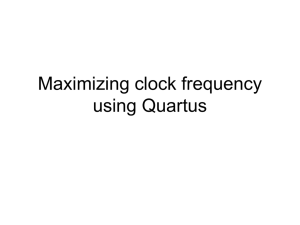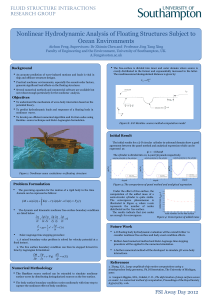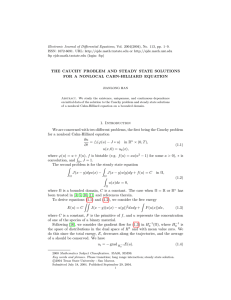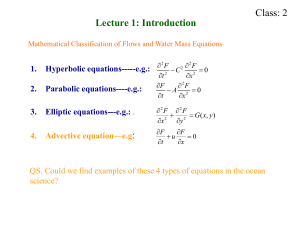On Efficient Numerical Methods for Phase Field equations
advertisement
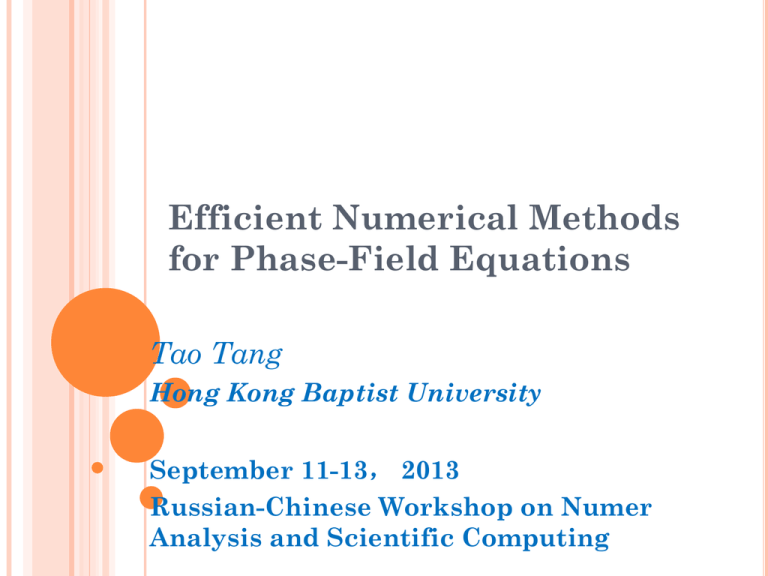
Efficient Numerical Methods for Phase-Field Equations Tao Tang Hong Kong Baptist University September 11-13, 2013 Russian-Chinese Workshop on Numer Analysis and Scientific Computing John W. Cahn (1928 -- ) John E. Hilliard (1826-1987) The Cahn-Hilliard equation: describes the process of phase separation: u u f (u ) t Microstructural evolution under the Cahn–Hilliard equation, demonstrating distinctive coarsening and phase separation. PHYSICS Cahn-Hilliard equation u u f (u ) t Phase separation in a binary alloy (metal, liquid, …) Spinodal decomposition Mass conservation Interface minimization MATHEMATICS 2 E (u ) u F (u ) dx 2 d u (t ) H 1 E (u (t )) dt d d E (u (t )) u (t ) dt dt 2 0 H 1 High-order nonlinear diffusion equations: How to do time integration? If both dynamics and steady state are required,how to do efficient time discretization? Higher order methods vs. efficiency; Adaptivity Examples of high order nonlinear diffusion equation Molecular Beam Epitaxy (MBE) Model [T., Xu; WB Chen et ] 2 ht 2 h (1 h )h Inpaiting with Cahn-Hilliard Equation [A.L. Bertozzi, etc] ut u 1 W ' (u ) ( x )( f u ) Phase field crystal equation [Lowengrub, Wang, Wise etc] tt t (3 2 2) Thin Film epitaxy [J. Shen, X.M. Wang, Wise, etc] t ( )- - 2 2 2 EXAMPLE Cahn-Hilliard impainting 1 ' ut u F (u ) ( f u ) [Bertozzi etc. IEEE Tran. Imag. Proc. 2007, Commun. Math. Sci, 2011] Monotonic decrease of the energy functional during the coarsening process NUMERICAL CHALLENGES Interior layers (i.e. thin interface) see a figure Time discretization: Lower order (good for stability)? “h”-adaptivity; “p”-adaptivity? Thin-film epitaxy without slope selection Energy Cahn-Hilliard equation Energy Energy Allen-Cahn equation Energy curves of three different models EXAMPLE Consider the IBV problem for the Cahn-Hilliard Eq. t u (u u 3 u ) 0, u ( x,0) u0 ( x), ( x, t ) R x Explicit Euler’s scheme (10-7) Semi-implicit Euler’s scheme (10-4) Implicit Euler’s scheme (10-6)! Non-linearly stabilized scheme (implicit for the biharmonic and non-linear terms : -- 10-3) Linearly stabilized splitting scheme: introducing two splitting functionals; one is contractive and the other is expansive: (10-2 ~ 10-3) A stable first-order method: t 0, in ut E (u ) u (t 0) u0 in E (u) 0, u E(u) , as u J (E)(u)u, u , u, J (E )(u) dE (u ) E (u ) dt E 2 Eyre’s method Convexity splitting E(u) Ec (u) Ee (u) where Ec , Ee C 2 and are strictly convex. The semi-implicit discretization is given by U k 1 U k t (Ec (U k 1 ) Ee (U k )) Various Eyre’s type or various extension: Inpaiting problem [Schönlieb & Bertozzi] Coarsening simulations [Vollmayr-Lee & Rutenberg] Second-order convex splitting [J. Shen, C. Wang, Wise] Question: Given Eyre’s GS scheme, can we use some iterative ideas to obtain a higher order semistable method? Spectral deferred Correction (SDC) for y’=f(t,y) The method is introduced by Dutt, Greengard and Rokhlin (BIT, 2000) Multi-implicit SDC method (Layton and Minion, 2004) SDC with high-order RK schemes [Christliek, Qiu and Ong, 2010] t y(t ) y(tn ) f (s, y(s))ds, t [tn , tn1 ]. tn Collocation Method: Y (t ) U n K mY tn ,i m m f (tn, j , j ) ln , j ( s)ds tn j 1 1i m Algorithm (SDC method) 1 (Prediction). [0] [0] [0] T Use a k0-th order numerical method to compute [1 , ,m ] 2 (Correction). For j=1,…,J Compute the residual for [ j 1] [ j 1] un Km [ j 1] [ j 1] Define the error function for [ j 1] e[ j 1] (t ) ym (t ) Lm ( [ j 1] ) Form the error equation e(t ) Km (e(t ) Lm ( [ j 1] )) Km [ j 1] Lm ( [ j 1] ) Use an k-th order method to compute i[ j 1] e(tn,i ) at the grid points tn,i on [tn,tn+1]. Define a new approximation solution [ j ] [ j 1] [ j 1] Convergence analysis [T., H.-H. Xie, X.-B. Yin, JSC 2012] Theorem 1: Let [ J ] be computed in the Correction step of the SDC Algorithm. If the step-size h is sufficiently small, then the following error estimate holds: ym [J ] Ch k0 J y k0 J Ch m y m 1 Outline Ym [ j ] Km [ j 1] Km [ j ] KmYm Km [ j 1] Ch Y Ym [ j ] Ch [ j 1] [ j ] Ym [ j 1] Ym [ j ] [ j] [ j 1] Y m m Ym [ j ] Ch Ym [ j 1] Ym [ J ] Ch J Ym [0] Note K m1 K m 2 Ch 1 2 Algorithm (Modified SDC method) : Same as Algorithm 1, except that after Picard smoothing [ ] un K m [ 1] , 1, [ j 1] is computed we use some , k 1, ( S1) [0] [ j 1] . After the above k-1 iterations, let ( S 2) [ j 1] [k 1]. Theorem 2 Let be computed in the Correction step of the modified SDC Algorithm. If the step size h is sufficiently small, and if special collocation points (e.g. Gauss) are used, then [J ] Ym [ J ] Ch Jk k0 y k0 2 m 1 Ch y 1, m 1, . Proof. It follows from (S1) that [ ] Ym KmYm Km [ 1] [ k 1] Ym Chk 1 [0] Ym Chk 1 [ j 1] Ym Ym [ j ] Chk [ j 1] Ym Ym [ J ] Ch Jk Ym [0] Efficiency comparison using Legendre-Gauss quadrature nodes Energy evolutions with different time steps FIRST-ORDER LINEAR SCHEME Simple, linear discretization in time; First-order with energy decreasing; In space, central differencing FFT is used STABILTY+ACCURACY VIA P- ADAPTIVITY Use Energy difference at t n and tn 1 steps Eh (u n ) Eh (u n 1 ) If the difference is small, no correction; If the difference is large, judge how many SDC corrections are needed. Note most of time regimes, no corrections are needed coarse mesh with correction u0 ( x, y) 0.05sin x sin y 0.001 Energy evolutions with different time steps and different numbers of corrections for the Cahn-Hilliard equation Blowing up phenomenon of semi-implicit spectral deferred correction with uniform number of corrections HOW MANY ITERATIONS NEEDED N max n n 1 0, if Eh (u ) Eh (u ) N max k N max k 1 n n 1 N p k , if Eh (u ) Eh (u ) , n n 1 1 N max , if Eh (u ) Eh (u ) Energy curves of the thin film model without slope selection and number of corrections CPU time comparison Adaptive Time Stepping: Energy is an important physical quantity to reflect the structure evolution. Adaptive time step is determined by t max(tmin , tmax 1 | E(t ) |2 ) ∆tmin corresponds to quick evolution of the solution, while ∆tmax to slow evolution. [Qiao, T., Zhang, SISC, 2010] Time adaptivity via energy variation (Xie; T., Luo) Numerical Scheme for C-H eqn: U nj ,k1 U nj ,k t n 12 j ,k h U nj ,k1 U nj ,k Eh (U ) 2 2 hU n 12 j ,k , U nj ,k1 U nj ,k (U nj ,k1 )2 (U nj ,k )2 2 2 2 1 U 1 4 h h 2 h. Stability: Eh (U n1 ) Eh (U n ). Discrete energy identity: Eh (U n 1 ) Eh (U n ) n 12 h t 2 h 0 U nj ,k1 U nj ,k 2 Equi-energy: • It follows from the numerical scheme and the energy identity that n 1 h 2 U n 1 U n n 1 n 12 Eh h 2 h • The prescribed energy decrease ( E ) equation n 1 h 2 U n 1 U n n 12 E h 2 h •Time stepping formula t E h n 12 2 h •One step fix-point iteration to solve the prescribed energy decrease equation The initial condition is random in [-0.1,0.1], with periodic boundary condition and 0.001 Example [artificial dissippation] Molecular Bean Epitaxy (MBE) Model: Model eqn: ht = -2h - [ (1 - |h|2)h ] Energy identity: d E ( h ) ht 0 dt where 2 1 2 E (h) h 1 h 4 2 2 ARTIFICIAL DISSIPATION: Remedy: h n1 h n 2 h n1 Ah n1 [(1 | h n |2 A)h n ] t i.e. an O(t) is added, where A > 0 is an O(1) constant. Property: If the constant A is sufficiently large, then E(hn+1) E(hn)? If the numerical solution is convergent, then the condition for A is 3 1 2 A h , 2 2 T & C.Xu: [SINUM, 2006] a.e. in (0, T ] MORE ON REGULARITY: Consider the nonlinear 2-D model for epitaxial growth of thin films: ht [(| h |2 1)h] 2h, 0, Here, we prove an a-priori bound on the L-norm of h in the 2-D case with =0. The proof heavily relies on the maximum principle. It is hard to see how it can be extended to the case of (small) positive . However, it is intuitively clear that in the case of positive , the solution should be more regular, and one may expect that the similar bound on h still holds. Conclusions/Remarks High-order time discretization is needed for highorder nonlinear diffusion equations. The use of the SDC method seems a useful way. Analysis of nonlinear stability and convergence require deep understanding of the relevant PDEs and numerical methods. [local estimates … T. & Xu SINUM 2006, Bertozzi etc] The analysis for adaptive schemes is highly nontrivial. Most of the existing numerical methods are lack of rigorous mathematical justification. Thanks! http://www.math.hkbu.edu.hk/~ttang
